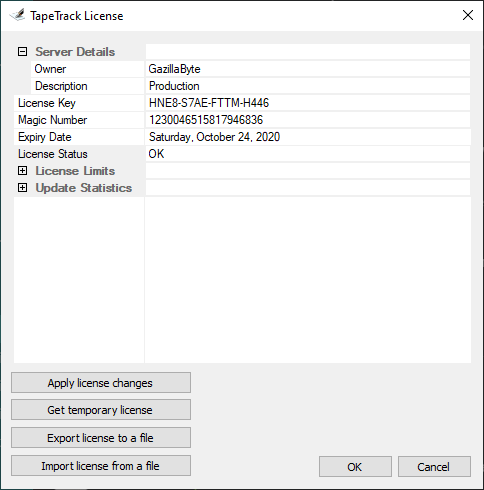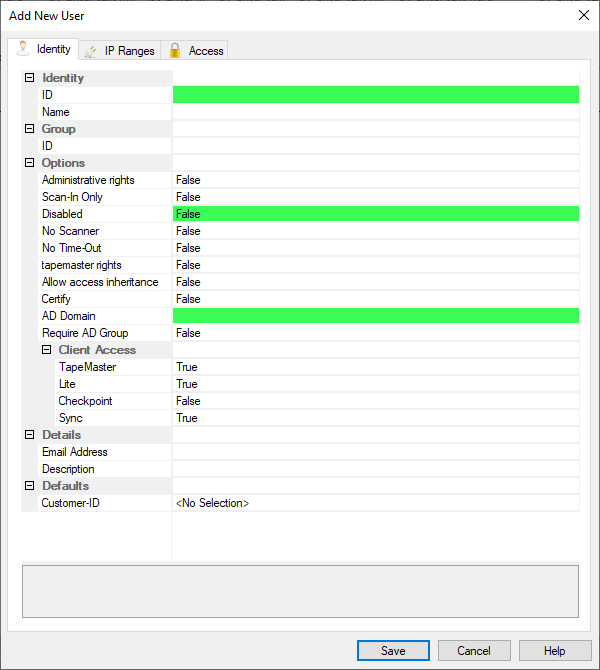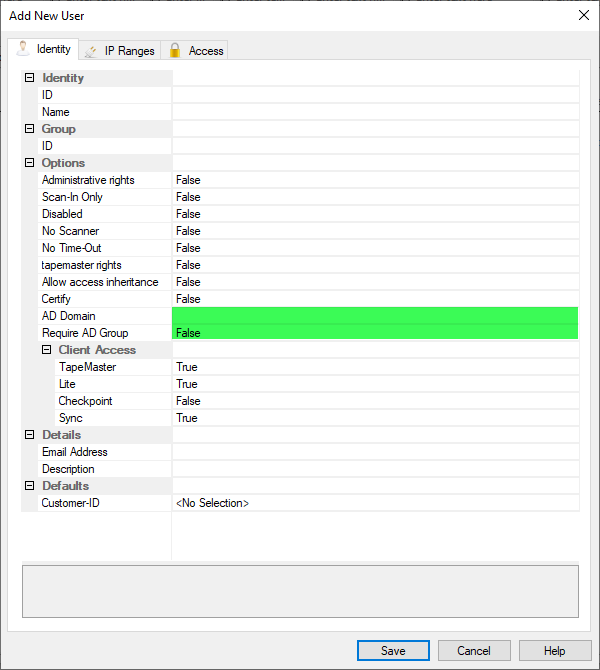Table of Contents
Upgrading
There are many reasons to upgrade both hardware and software, unsupported releases, security updates or simply making use new features.
The process of performing an upgrade can be as simple as reinstallation of a software package all the way through to a complete hardware rebuild and a new operating system or migration from a physical server to the cloud.
Upgrading TapeTrack Client Software
As TapeTrack is a Client/Server architecture, upgrading the client side software is a fairly simple process as there is no need to backup the database or stop the Framework Server whilst the upgrade is completed. The other point to remember, upgrading TapeMaster (or Lite, or Checkpoint) on one computer will only affect that computer. Any other computers you have TapeTrack Client Software installed on will need to be updated on their own. It is also possible to have different versions of TapeMaster (or Lite, or Checkpoint) on several computers all able to simultaneously connected to the Framework Server.
Upgrading TapeTrack Desktop Client Software Process:
- Downloading the latest release executable
- Uninstalling the currently installed version
- Installing the latest release
For detailed information see:
Upgrading Lite
Upgrading TapeMaster
Upgrading Checkpoint
Upgrading TapeTrack Server Software
Upgrading the Framework Server, although similar to the Desktop Client side software, requires a few more steps to ensure the database integrity is maintained.
You will also need to schedule a time to perform the upgrade as you will need to shut down the Framework Server so consideration will need to be given to when any Syncs are scheduled or Customers may be accessing the data.
For detailed information see Upgrading Server.
Other Considerations
TapeTrack License
If you are upgrading your hardware, Virtual Server or migrating to the Cloud there is a possibility of the MAC address of your server changing.
As your TapeTrack License Key is based off your Owner name, Expiry date and the MAC address, the current License Key will become invalid if any of these alter.
If your server has internet access, you can apply for a Temporary License Key, which will allow your to start using TapeTrack immediately, as well as give you two weeks grace period to contact the support desk for a Permanent Key based off your true License expiry date.
If you don't have internet access, you will need to apply for a Permanent license to regain access to TapeTrack.
Letting support know your upgrade plans will allow a TapeTrack technician to be available to assist in cutting a new Software Key and License installation to get you back up and running as quickly as possible.
Taking a screen shot of your TapeTrack License before your upgrade will help with noting the Owner name, and your current expiry date.
Windows AD Login
If you, and other users, use Windows Active Directory integration to log into TapeTrack your User Identity in TapeTrack mirrors your Windows AD user name.
If your upgrade is moving your users to another domain, or altering your Windows AD username the TapeTrack usernames will need to be updated to match.
As a User-ID in TapeTrack cannot be edited, you will need to create new User-ID's for each User to match your new Domain name, as well as updating the new AD domain in the User's Identity tab.
If you wish to maintain previous User-ID's for audit, or any other, purposes instead of deleting the User-ID's, they can be disabled in the User's Identity tab. This will make the User-ID inactive and stop any further access.
See Add New User on information to add new Users or access User Identity tab.
TMSS10Sync
If you are synchronizing TapeTrack with your Libraries, chances are you are using TMSS10Sync to do it.
This program is usually installed on the same server as your TapeTrack Framework Server, default installation location is C:\Program Files\TapeTrack\TapeTrack Sync, although the location can be where ever was specified at installation, so if it is not in that location you will need to ascertain where it was installed, the next likely location would be D:\Program Files\TapeTrack\TapeTrack Sync.
TMSS10Sync works in a 3 step process:
- Extract data from your Library
- Process the data in TapeTrack
- Report on the result of the Sync
As well as optionally emailing the results, if set up to do so.
Within the TapeTrack Sync will be several folders:
- bin
- Contains the executables, these files will be created when installing TMSS10Sync on the new server so don't need to be backed up.
- etc
- In a standard installation this folder will contain your ttidef file. This file is used to translate the information imported from your libraries to a format for inputting into TapeTrack. This file is customised for your system and you will need to back this up and place it in the same folder on the new installation.
- reports
- Output from the Sync process is normally saved to this directory, while not required for the new installation, you may wish to backup these reports if you archive them or will need to reference them in the future for any reason.
- scripts
- This folder will contain one or several batch files that execute the Sync process. These files are custom for your Sync and will need to be backed up and and place it in the same folder on the new installation.
- var
- On installation the var folder contains a sample CSV file, as an example on how to import data into TapeTrack. If this is the only file in this folder you will not need to back it up, it will be created with the new installation. If you have other customised files in this directory you will need to back them up and place in the same directory on the new installation.
Almost all installation of TMSS10Sync have the code to execute the program contained within a batch file that is executed by Windows Scheduler, or another scheduler, that runs the Sync at a pre-set schedule. Take note of the files that are executed by the scheduler as well as permissions, execution time and execution repetition so you can recreate this automation on the new installation.
Remember to check the batch files and update the User-ID, password and/or server address if any of these values have been changed. This will be in the format -S user:-password@Server. More details on the Server Argument can be viewed at Server Argument.
As well as updating any parameters involved in emailing the output files if required.
Server Utilities
TapeTrack Server Utilities are a collection of executables used for automating tasks and creating reports. These files, while able to be executed manually are usually via batch script and scheduled automation.
The Server Utilities executables will all be created by the installation of the Server Utilities installer.
Any batch file scripts that reside in the Server Utilities directories will need to be backed up and placed in the same folders on the new installation.
As the Server Utilities can be run also be run from client side computers, any alteration to the User-ID and passwords as well as the Server address (or IP) will need to be upgraded in the batch file code.
Domains
If you are changing the Windows Domain you will need to:
- Create a new User-ID for each user that logs in using the Windows AD feature of TapeTrack if their Windows User-ID is altered in the process as TapeTrack User-ID's much match the Windows AD username to access this function.
- Update connection attributes in TapeTrack Client software if the connection details to the Framework Server alter.
Email server
Migrating To The Cloud
Migrating to the Cloud, TapeTrack will function the same as installed on your own hardware except for the Windows AD login function.
Each user will need to have a password, stored in the TapeTrack Server, for authentication when logging in.
This will mean Users will no longer need to check the No MD5 checkbox on the login screen.
If you have the Active Domain and Require AD Group selected in the Users Identity tab, you will need to remove the Active Domain and set 'Require AD Group'' to false
Visual Runtime
TapeTrack utilizes Microsoft Visual Runtime Libraries to minimize the size of the executables as well as take advantage of Microsoft Security updates for these components, without the need for you to update TapeTrack each time such an update is available. It also stops multiple installations of the same DLL files as they can be shared by multiple applications and ensures you get the most up to date version at the time of installation.
If you are upgrading your operating system or your version of TapeTrack, you may need to download and install the relevant version of Visual Runtime to match. The TapeTrack installer will check for the presence of the required Visual Runtime and notify you if this component is required to be downloaded and installed as part of the installation. If you don't receive a popup prompting to install the Visual Runtime package, TapeTrack installer has confirmed it is already installed.
If you need to install the Visual Runtime Package, instructions can be viewed here.
The latest supported releases can be downloaded from Microsoft Visual C++ downloads



